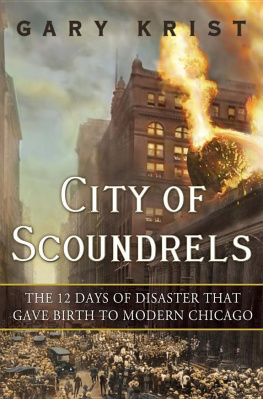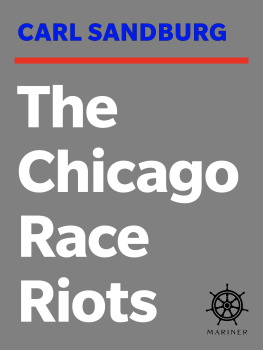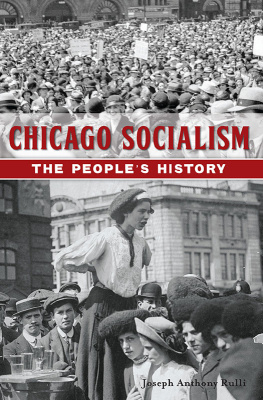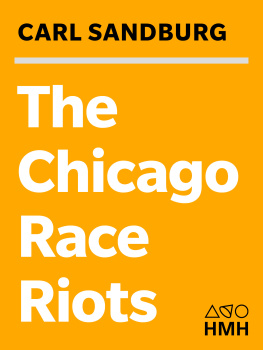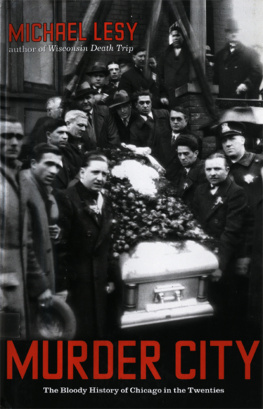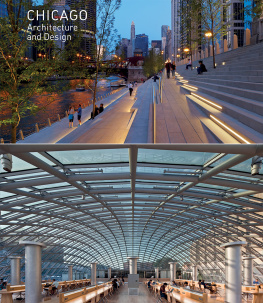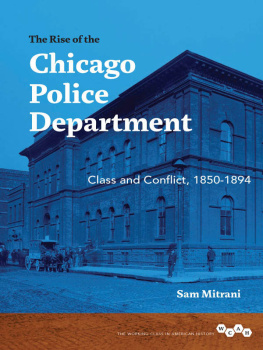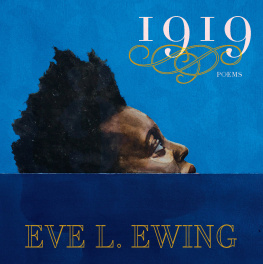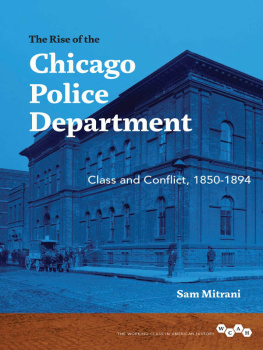ACKNOWLEDGMENTS

I FIRST ARRIVED in Chicagolike many a newcomer over the past two hundred yearswith no idea of what I was letting myself in for. The city is so much bigger, brasher, subtler, and rifer with wonders, idiosyncrasies, and complexities than anything that can be captured on paper or screen that someone facing it for the first time (or even the hundredth time) is bound to feel overwhelmed. For the narrative historian in particular the city can be hugely daunting. There were times in my research when it seemed that more happened in Chicago in a single week of 1919 than happened in most places over the course of several years.
I was therefore fortunate to find so many people ready and willing to help me make sense of this embarrassment of riches. Much of my research occurred during tough economic times, so a lot of these people were facing the pressures of slashed budgets, curtailed hours, and staff shortages, but never were they anything less than generous with their time and expertise. I owe particular thanks to Lesley Martin of the Chicago History Museums Research Center, who has been a gracious and informative guide to the museums vast collections since the very beginning of this project. Lesley, along with Debbie Vaughan, Anne Marie Chase, and everyone else at the center, deserves the gratitude of all who care about the citys varied and fascinating past. I also got plenty of help from the staffs of the University of Chicagos Special Collections Research Center (where the Lowden and Wells-Barnett papers are held), the Newberry Library (which has the Lawson and Lardner archives), the Harold Washington Library Center (especially those in the Newspaper Microfilm Room and the Municipal Reference Collection), the Vivian G. Harsh Research Collection of Afro-American History and Literature, the library of the University of Illinois at Chicago, and the Spertus Institute of Jewish Studies (with particular thanks to Kathy Bloch). For her regular online doses of Second City lore, and for her enthusiasm about this project, Id also like to send regards to Sharon Williams, author of the wonderful blog called Chicago History Journal (http://www.chicagohistoryjournal.com).
I received welcome aid outside of Chicago from Eric Gillespie of the Colonel Robert R. McCormick Research Center in Cantigny, Illinois; Chatham Ewing, Dennis Sears, and the staff of Special Collections at the University of Illinois at Champaign-Urbana (where the Sandburg papers are housed); and Christyne Douglas and Beth Howse of Fisk Universitys Special Collections in Nashville. Closer to home, Id like to acknowledge the employees of the Library of Congress, the National Archives (Archives II), and the University of Maryland libraries.
And to the people at the Cook County Medical Examiners Office who tried hard to find the inquest documents I was looking for, Id like to say Thanks for trying.
Among the historians who offered me guidance and suggestions along the way, special mention must go to Douglas Bukowski, William Hale Thompsons most insightful biographer. Doug and I dont agree on everything Big Bill, but he has been incredibly generous with his time and his research, once even lending me his copies of some old FBI files that the Bureau itself no longer has. I now consider Doug a friend, and I apologize to him for those suggestions of his that I ended up not taking. Id also like to express my gratitude to historians Sarah Marcus (now of History Works), Dominick Pacyga of Columbia College in Chicago, and Margaret Garb of Washington University in St. Louis for various comments and advice, and to Carl Smith of Northwestern University, who helped steer me to important sources very early in my research. And, as always, this book is better for having passed before the editorial eye of my pal Lisa Zeidner.
I owe enormous thanks yet again to my astute, erudite, and debonair agent and friend, Eric Simonoff at William Morris Endeavor, and to his assistants Eadie Klemm and Britton Schey. At Crown, Id like to thank Rachel Klayman, Molly Stern, and especially my editor Sean Desmond and his assistant, Stephanie Chan, for their enthusiasm, insight, and gameness above and beyond the call of duty. And finally, Id like to express gratitude to my familyElizabeth Cheng, Anna Chang-Yi Krist, and Lilyfor being just about the most wonderful spouse, child, and hound (respectively) I can imagine.
ALSO BY GARY KRIST
The White Cascade
Extravagance
Chaos Theory
Bad Chemistry
Bone by Bone
The Garden State
ABOUT THE AUTHOR

G ARY K RIST has written for the New York Times, the Wall Street Journal, GQ, Esquire, Salon, the Washington Post Book World, and other publications. He is the author of the acclaimed book The White Cascade: The Great Northern Railway Disaster and Americas Deadliest Avalanche, as well as several works of fiction.
BIBLIOGRAPHY

BOOKS
Abbott, Karen. Sin in the Second City: Madams, Ministers, Playboys, and the Battle for Americas Soul. New York: Random House, 2007.
Addams, Jane. Peace and Bread in Time of War. 1922. Reprint, New York: Garland, 1945.
. The Second Twenty Years at Hull-House. New York: Macmillan, 1930.
. Twenty Years at Hull-House. 1910. Reprint, New York: Signet, 1961.
Adler, Jeffrey. First in Violence, Deepest in Dirt: Homicide in Chicago, 1875 to 1920. Cambridge, MA: Harvard, 2006.
Algren, Nelson. Chicago: City on the Make. Oakland, CA: Angel Island, 1961.
Allen, Frederick Lewis. Only Yesterday: An Informal History of the 1920s. 1931. Reprint, New York: Bantam, 1959.
Allswang, John M. Bosses, Machines, and Urban Voters. Rev. ed. Baltimore: Johns Hopkins, 1986.
. A House for All Peoples: Ethnic Politics in Chicago, 18901936. Lexington, KY: University Press of Kentucky, 1971.
Anderson, Alan B., and George W. Pickering. Confronting the Color Line: The Broken Promise of the Civil Rights Movement in Chicago. Athens, GA: University of Georgia, 1986.
Anderson, Margaret. My 30 Years War: An Autobiography. Chicago: Covici, Friede, 1930.
Anderson, Philip J., and Dag Blanck. Swedish-American Life in Chicago: Cultural and Urban Aspects of an Immigrant People, 1850 to 1930. Champaign, IL: University of Illinois, 1992.
Anthony, Carl Sferrazza. Florence Harding: The First Lady, the Jazz Age, and the Death of Americas Most Scandalous President. New York: Morrow, 1998.
Ascoli, Peter M. Julius Rosenwald: The Man Who Built Sears, Roebuck and Advanced the Cause of Black Education in the American South. Bloomington, IN: Indiana University, 2006.
Asher, Robert, and Charles Stephenson, eds. Labor Divided: Race and Ethnicity in United States Labor Struggles, 18351960. Albany: SUNY, 1990.
Asinof, Eliot. Eight Men Out: The Black Sox and the 1919 World Series. New York: Holt, 1977.
Aylesworth, Thomas G., and Virginia Aylesworth. Chicago: The Glamour Years, 19191941. New York: Gallery, 1986.

